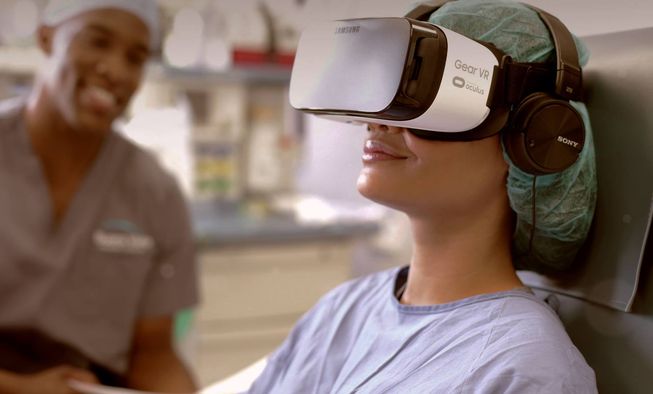Virtual Reality (VR) has been known in the gaming industry for a while now, but it has brought a range of new services into the healthcare industry too. The experience provided by Virtual Reality is being used in a variety of healthcare-related applications. There are four medical areas in which VR is active: therapy, surgery related applications, training, and medical research. In this blog we take a closer look at Virtual Reality Therapy (VRT). ‘VRT is the use of simulated interactive and immersive environments as a tool for physical or psychological healthcare applications’.
VRT is mainly used for phobias & posttraumatic stress disorder (PTSD). Cognitive-behavioural therapy has been used to treat a variety of phobias since the 1950s. In this type of therapy, patients learn to identify the thoughts that are causing the feelings or behaviours they want to overcome, and then learn how to replace those thoughts with more helpful ones. Exposure to this is a key component of most cognitive-behavioural therapy. One of the most common phobias is acrophobia, the fear of heights. With the use of VR an environment can be created where the user can be on top of a tall building or working on unstable scaffoldings. This allows the patient to become familiar to the situation and over time control this phobia better. The video below shows how it works.
https://www.youtube.com/watch?v=zhljsCx6Yiw
Multiple VRT applications have been developed to heal patients with other healthcare problems. One of them is MindMaze VR rehabilitation platform. This firm is testing VR in hospitals with victims of a stroke, amputees, and people suffering from other debilitating conditions, to help them regain their muscle strength and movement. Kortex is another VR platform, it helps with stress and sleep problems as it stimulates the mind to create the sleep-stimulating hormones melatonin and serotonin.
Many VR applications in the medical sector are still niche; yet, medical professionals, hospitals, and medical institutions drive growth in the sector by increased interest. ABI Research predicts that: ’VR services in the medical and healthcare segment will generate US$8.9 million in 2017 and will grow to US$285 million in 2022’. This means in increase of more than 3.000%.
To end this blog I would like to refer to a quote by Daniel Freeman, professor of clinical psychology at the University of Oxford, who has been working with VR for 16 years. “There are very few conditions VR can’t help because, in the end, every mental health problem is about dealing with a problem in the real world, and VR can produce that troubling situation for you.”
ABIresearch. (2017) ‘Virtual Reality in Medicine and Healthcare to Generate US$285 million in 2022’. Available at: https://www.abiresearch.com/press/virtual-reality-medicine-and-healthcare-generate-u/ (accessed at 7 October 2017)
Hattenstone, S. (2017) ‘After, I feel ecstatic and emotional’: could virtual reality replace therapy?. Available at: https://www.theguardian.com/technology/2017/oct/07/virtual-reality-acrophobia-paranoia-fear-of-flying-ptsd-depression-mental-health#img-2 (accessed: 8 October 2017)
O’Dowd, E. (2017) Healthcare Virtual Reality Potential Grows for Therapy, Surgery. Available at: https://hitinfrastructure.com/news/healthcare-virtual-reality-potential-grows-for-therapy-surgery (accessed: 9 October 2017)
Vanian, J. (2017) Leonardo DiCaprio Adds Virtual Reality Startup to List of Investments. Available at: http://fortune.com/2017/09/22/leonardo-dicaprio-investments-mindmaze-vr/ (accessed: 8 October 2017)
Winerman, L. (2005) A virtual cure. Available at: http://www.apa.org/monitor/julaug05/cure.aspx (accessed: 9 October 2017)


Good Article! I really liked your subject. Although Virtual Reality is not a new concept for me, the implementation of Virtual Reality in therapy is. I found it especially interesting because of my personal experience dealing with anxiety, atychiphobia (fear of failure phobia). Therefore, I was very curious about studies that showed how this VRT succeeded for the patients. I couldn’t find one in particular, but I did find an article that tells something about a documentary where they invited people to try the VRT. This girl, Rochelle Bisson, explains how the VRT helped her to face her fear of being trapped. I thought it was quite special to read about it and to see how far VRT has become. I guess this promises a lot for in the future, and could maybe even be a solution for myself..
http://metro.co.uk/2017/09/25/how-virtual-reality-therapy-helped-me-face-my-fear-of-being-trapped-we-talk-anxiety-and-cleithrophobia-on-mental-health-podcast-mentally-yours-6953732/
What an interesting article. Personally, I have never really thought about all the potential Virtual Reality has. I mainly know the VR glasses from providing entertainment to many people, so this was a very interesting article to read. Knowing mental health issues are more and more common these days, I now believe VR might be the way to tackle all these problems. I don’t think VR is only interesting from a healthcare perspective, but also economically! As metal illnesses cost the government billions and billions of dollar (I found 28 billion dollar in the UK alone), this should be a great investment with high potential. https://www.theguardian.com/science/blog/2017/mar/22/why-virtual-reality-could-be-a-mental-health-gamechanger